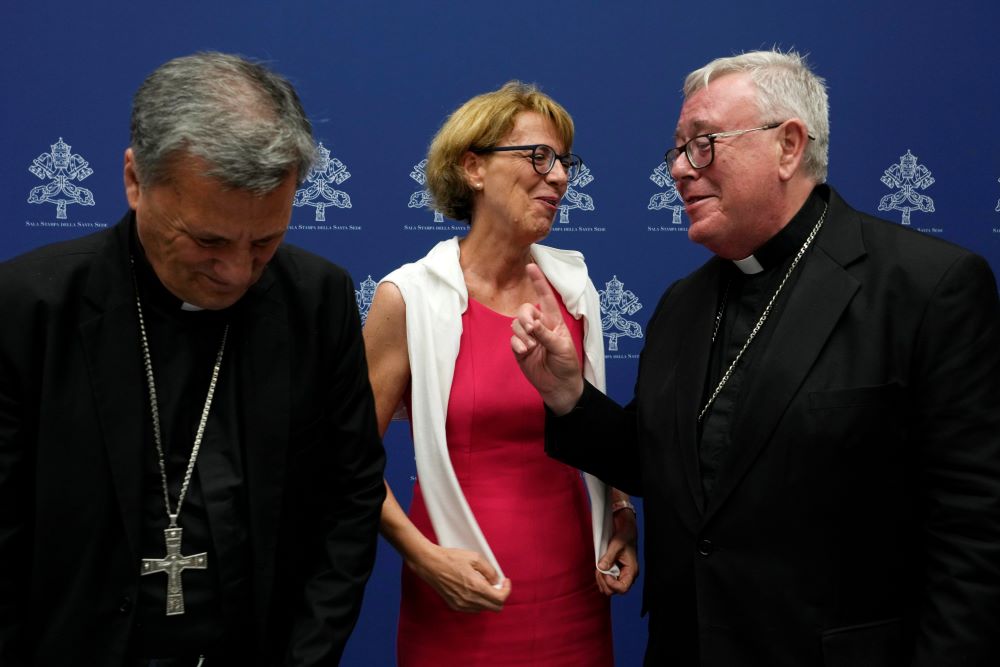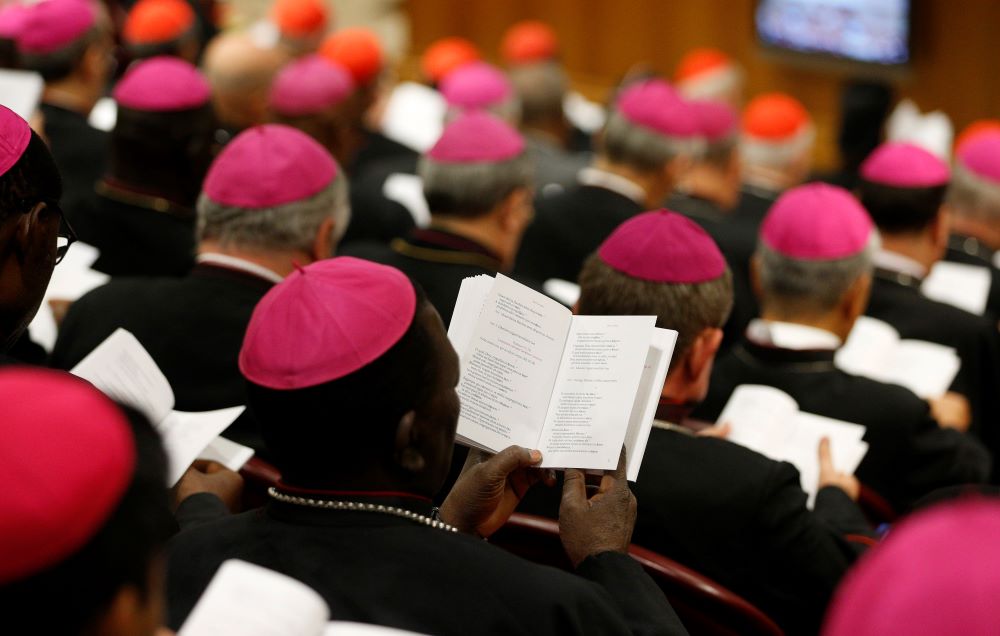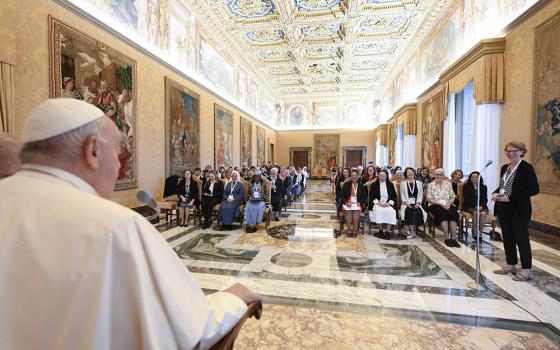
Helena Jeppesen Spuhler, center, talks with Cardinal Jean-Claude Hollerich, right, and Secretary General of the Synod of Bishops Cardinal Mario Grech at the end of a presentation of the new guidelines for the Synod of Bishops at the Vatican June 20. (AP/Domenico Stinellis)
The first two things that jump out when reading the working document, or instrumentum laboris, for the forthcoming synod, which was released June 20, are how much the document charts a new approach to a working document for an ecclesial synod and how deeply the document is in continuity with the teachings of the Second Vatican Council.
Whoever came up with the idea of framing the document in terms of questions, rather than a draft text, deserves a bonus. For starters, it puts to rest one of the most common complaints about the synodal process coming from the anti-Francis bleachers, namely, that this synodal process is a smokescreen for a predetermined agenda to radically change the moral teachings of the church. After Cardinal Robert McElroy called for the synod to achieve a "radically inclusive" church earlier this year, conservative theologian Larry Chapp opined, "What it all amounts to is code for the ascendancy in the Church of the moral ethic of secular modernity and its imposition on everyone in the Church via the pathway of deceptively pre-engineered, faux democratic processes designed to produce predetermined results."
Predetermined results? For the first time, the instrumentum laboris does not present a draft of a final document for the synodal assembly to amend, but a series of questions. These questions reflect the ones raised in the worldwide consultations. The planning committee did not draft a set of plausible responses. It did not lean into the neuralgic issues one way or the other. It acknowledges them and, in so doing, also acknowledges that the effort to declare some topics closed failed to stop the questioning.
The working document does, however, frame the issues, neuralgic and pedestrian, raised in the consultation process, and the frames it uses are all drawn from the ecclesiology of Vatican II. And, so, the first set of questions is grouped under this category and question: "A communion that radiates: How can we be more fully a sign and instrument of union with God and of the unity of all humanity?"
This is almost word for word from the opening paragraph of Vatican II's Constitution on the Church, Lumen Gentium, which reads: "Since the Church is in Christ like a sacrament or as a sign and instrument both of a very closely knit union with God and of the unity of the whole human race, it desires now to unfold more fully to the faithful of the Church and to the whole world its own inner nature and universal mission."
I see also in this awareness that the church's self-understanding is achieved in part by its mission to the world an echo of the brief remarks then-Cardinal Jorge Maria Bergoglio made to his fellow cardinals shortly before they elected him pope. "The evils that, over time, happen in ecclesial institutions have their root in self-referentiality and a kind of theological narcissism," Bergoglio told them."In Revelation, Jesus says that he is at the door and knocks. Obviously, the text refers to his knocking from the outside in order to enter but I think about the times in which Jesus knocks from within so that we will let him come out. The self-referential Church keeps Jesus Christ within herself and does not let him out."
This pastoral intuition grew out of Bergoglio's experience of the reception of Vatican II in Latin America. It is neither a left or right insight. It brings the seeds planted at Vatican II to maturity.
The second group of questions also flows from a key conciliar insight: "Co-responsibility in Mission: How can we better share gifts and tasks in the service of the Gospel?" The fathers of the Second Vatican Council would not have put the question this way. But without the recovery of the central role of baptismal dignity in the life of the church evidenced in Lumen Gentium such a question would not be possible. As the instrumentum laboris states earlier in the document, "a synodal Church is founded on the recognition of a common dignity deriving from Baptism, which makes all who receive it sons and daughters of God, members of the family of God, and therefore brothers and sisters in Christ, inhabited by the one Spirit and sent to fulfill a common mission."
That focus on the common dignity of the baptized also revolutionized the church's ecumenical efforts at Vatican II and since, just as the council's consideration of the common dignity of the human person made dialogue with non-Christian religions possible in a way they had not been before. The image of Popes John Paul II, a Pole, and Benedict XVI, a German, visiting the death camp at Auschwitz-Birkenau, was unthinkable before Vatican II. Obviously, non-Christians are not "co-responsible" for Catholic mission, but those entrusted with Catholic mission must, after Vatican II, be mindful that God is already at work in the world before we come to evangelize.

Bishops pray at the start of a session of the Synod of Bishops on Young People, Faith and Vocational Discernment at the Vatican Oct. 9, 2018. The Vatican released its working document, or "instrumentum laboris," for the upcoming world Synod of Bishops on June 20. (CNS/Paul Haring)
It is only after the subject of mission has been addressed that one can turn to issues of participation, governance and authority, which form the third category of items the synod will consider. In this section, most questions are essentially practical. For example, "How can seminaries and houses of formation be reformed so that they form candidates for ordained Ministry who will develop a manner of exercising authority that is appropriate to a synodal Church?" and "To what extent does the shortage of Priests in some regions provide an incentive to question the relationship between ordained Ministry, governance and the assumption of responsibilities in the Christian community?"
Practical or not, this is the section in which we can foresee the most difficulties.
Some conservative critics have been frantically worried that the working document would lead the Catholic Church astray. Last November, after the release of the working document for the continental stage of the synod preparation, George Weigel complained, "This has nothing to do with Vatican II."
EWTN's Raymond Arroyo last week featured an "encore presentation" from earlier in the month, in which he interviewed Cardinal Raymond Burke, former archbishop of St. Louis, former prefect of the Apostolic Signatura and former patron of the Order of Malta, who now has no particular assignment. The cardinal offered this enthusiastic endorsement of the process: "The fact of the matter is that there is no clear idea of what synodality is. It's certainly not a mark of the Church." Thank you, your eminence, for that thoughtful commentary.
The joke is on the critics. The working document contains precisely the combination of elements of continuity and discontinuity that constitute the "hermeneutic of reform" with which Pope Benedict XVI said the council should be interpreted in his famous 2005 Address to the Roman Curia. The citations from Scripture throughout the document are not cherry-picked. They are ecclesiologically foundational. The vision is deeply rooted in the teaching of Vatican II.
Advertisement
The vision of a synodal church that emerges from this document is also something else. It is a sign of that "abundant 'more' that signals God is at work" of which Pope Paul VI spoke and which I highlighted in my review of a new book by Cardinal Michael Czerny and Fr. Christian Barone. Discussing the reports from those who participated in the synodal process, the working document states: "One common trait unites the narratives of the stages of the first phase: it is the surprise expressed by participants who were able to share the synodal journey in a way that exceeded their expectations."
We can note that many Catholics have low expectations at this moment in church history, but that sentence, like the rest of the text, is brimming with hope. People's expectations were "exceeded." Surely, this is a mark of the church, no matter what Cardinal Burke says. When we surrender to God, and become docile to the Holy Spirit, then, and only then, do we experience the joy the first apostles experienced when their expectations were dashed by Jesus of Nazareth's ignominious death. We, like they, and like Christians in every epoch, are called to trust in the Lord in the circumstances of our times.
This document, collecting the insights from what is likely the widest consultative process in the history of the world, helps all of us to trust that the Holy Spirit is calling us to this synodal process and the ecclesial vision that is emerging, a vision rooted in the teachings of Vatican II and looking confidently forward.







